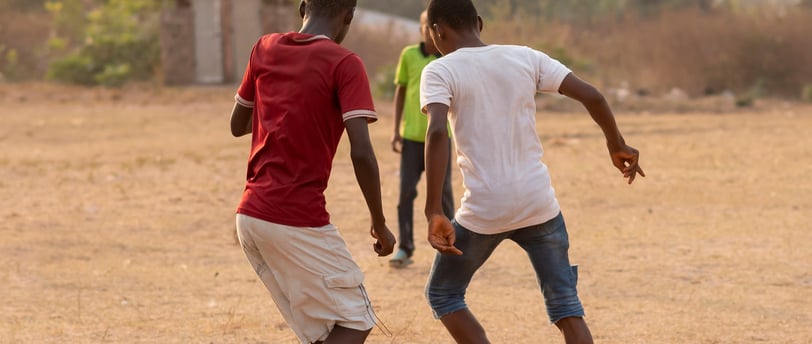Read football & basketball articles and other sports only at Finessekick.com
Barefoot Football: Traditions and Unique Matches in Remote Areas
Football has become a popular sport worldwide, including in remote areas with various limitations. Despite being far from the glitz of modern stadiums or advanced equipment, football in these regions has its own charm. One of its unique aspects is the tradition of playing football barefoot or with rules adapted to the local environment. This article will discuss various unique stories about how football is creatively played in remote areas, making it more than just a sport but also a symbol of culture and togetherness.
FOOTBALL
A. Sahrul Romadhon
11/2/20243 min read


1. Barefoot Football: A Grounded Tradition in African Villages
In some regions of Africa, playing football barefoot is not just due to economic limitations but also part of local culture and customs. Children and teenagers often play football on dirt fields without shoes, feeling direct contact with the soil, sand, or grass. They use balls sometimes made from makeshift materials, like wrapped cloth or tightly bound plastic.
Playing barefoot has its own significance for them, symbolizing closeness to nature and local cultural roots. Additionally, this habit gives players higher control and sensitivity to the ball. In some areas, there are special tournaments that require players to play barefoot as a way to preserve local traditions.
2. Mud Football Matches: The Uniqueness of "Mud Football" in Indonesia
In Indonesia, one unique type of football often played in rural areas is “mud football.” Mud football is usually played in muddy rice fields after the planting season ends. The slippery and muddy field conditions add a unique challenge for the players. They must maintain balance on difficult terrain while still trying to score goals.
Mud football is often held as part of village celebrations or local festivals, such as before major holidays or harvest celebrations. This game not only entertains but also teaches values of togetherness and perseverance, as playing in the mud requires high teamwork and patience.
3. Football in the Himalayas: The Challenge of Altitude and Thin Air
In high-altitude villages in the Himalayas, such as in Nepal and Bhutan, football is played despite being in extremely challenging terrain. Playing at high altitudes makes the air thinner, making every step more exhausting. Nevertheless, the players, including children, remain enthusiastic about playing with the ball, usually on dirt fields or even rocky open areas.
Football in the mountains is not only challenging but also showcases the physical and mental toughness of local players. Playing at high altitudes makes the lungs work harder, but they are accustomed to it and make it part of their lifestyle. Each match is not just a sport but also a form of appreciation for the nature surrounding them.
4. Football in the Desert: Extreme Challenges in the Sahara
In desert areas like the Sahara, playing football presents its own challenges. The hot and shifting sand requires players to have special techniques to maintain balance and control the ball. In some places in Morocco, Algeria, and Tunisia, football is played with simple equipment, where players are used to playing barefoot or only wearing sandals.
Amid limited facilities, communities in these areas utilize available spaces to hold matches. Playing football in the desert often becomes an event for the community to gather and socialize. Despite the harsh natural conditions, their spirit to play never fades. For them, football is a form of entertainment and a way to momentarily forget the harshness of life in the desert.
5. Football in Risky Environments: Playing on Riverbanks and Slopes
In some areas of Asia and South America, children and teenagers often play football in unusual locations, such as riverbanks or hillsides. Despite the risky locations, they play with full enthusiasm. Rocky fields or sloping terrain present unique challenges for players who must master balance and speed.
Playing in such places often stems from the limited flat land in their villages or regions. However, this condition does not dampen their spirit. They see natural challenges as part of the game that makes them more creative in overcoming obstacles.
Football as a Reflection of Culture and Identity
Football in remote areas is not just about the game but also a reflection of culture, identity, and the way of life of local communities. In different natural challenges and limitations, they create unique ways of playing according to their environmental conditions. This shows that football is an inclusive sport, capable of crossing geographical and social boundaries.
Players in remote areas do not chase popularity or the glitz of big stadiums. They play because of their love for football and the spirit of togetherness created on the field. Despite lacking modern facilities or expensive uniforms, they share one thing with professional players: a deep passion for football.
Conclusion
From the Himalayas to the Sahara, football is played uniquely in various parts of the world. For those living in remote areas, football becomes a means to gather, share joy, and preserve local traditions. Despite all limitations, this game continues to provide spirit and entertainment for local communities.
These stories remind us that the true essence of football does not lie in luxurious facilities or popularity but in the spirit, togetherness, and resilience shown by players on every field, regardless of its condition. Football proves to be a universal sport that can be enjoyed by anyone, anywhere.
FinesseKick.com
Discover the latest articles about the world of sports.
Know More
Contact
© 2024. All rights reserved.
